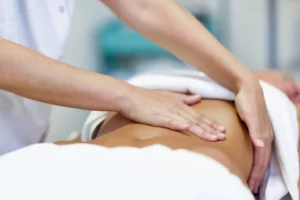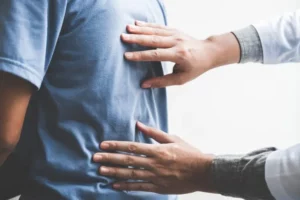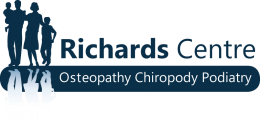How can Osteopathy Help with Digestion?
Osteopathy is the holistic practice used to detect, treat and suppress ailments through gentle massage and manipulation of joints and muscles. Digestive disorders can also be effectively treated using Osteopathy. Digestives issues can occur at all ages.
Various factors can cause digestive problems to occur such as age, diet, lifestyle, stress, and mental health. It causes further discomfort which includes:
- Constipation
- Abdominal Pain
- Diarrhea
- Indigestion
- Abdominal Cramps
- Heartburn
- Bloating
- Acid Reflux
- Hiatus Hernia
- Other Musculoskeletal Symptoms
Osteopathy for Digestive Problems

Visceral Osteopathy is considered as a part of Osteopathic techniques, that mainly focuses the digestive issues. Major digestive ailments that osteopathy treats are Irritable Bowel Syndrome (IBS), constipation, indigestion, flatulence, and heartburn.
Visceral Osteopathy can be of two different types. One helps stabilize the digestive organs, while the other maintains the proper movements and rhythm of digestive organs. Every organ of the body should be in their equilibrium movement so that they work properly.
Hence digestive movements are essential. Any derangement in proper movement may disturb the equilibrium, which results in pain. This limitation in the movement of organs may make the organ stop due to the restricted movement of smooth muscles.
Visceral Osteopathy
Visceral osteopathy aims at stabilizing the organs at the place, which means holding the organs and ligaments to their position, i.e., when we lie down, visceral organs would not go in one particular direction.
This, in turn, prevents the ligament of the digestive organ from proper functioning, thus causing pain over the gut. Hence proper mobilization and movement of digestive organs very essential in stabilizing them at their proper site. This also enhances the blood flow and oxygen supply to the area, which brings the healing process more accurate and beneficial for the gastrointestinal tract.
Osteopathy in Treating Digestive Issues
Osteopathic treatments mainly focus on rebalancing the impaired organs, muscles, joints, and tissues around. This balance thus restores the movement of organs and muscles and enhances blood and nerve supply.
The musculoskeletal system, which mainly controls movement plays a pivotal role in the occurrence of digestive disorders. Mainly those of an interruption in blood and nerve supply, tension and strain of abdominal muscles, restricted movement of organs and spine. These are caused by a variety of reasons which include falls, an injury, or trauma to pelvis ribs and back, following abdominal surgery.
Treating Digestive Problems

Osteopaths at Richards Osteopathy is very patient-friendly, as every treatment procedure is individual-specific, considering the cause and manifestation of the condition, which would be different for different individuals.
Our Osteopaths adopt the unique method in assessing and treating the direction and movement of different organs through Visceral Osteopathic Manipulation Techniques. The connection between the digestive system and other organs is made through ligaments and fascia. This also acts as a bridge that connects to the diaphragm and abdominal wall, along with the spine, ribs, and pelvis. Some of the processes, we include in treating the troubled digestive system includes:
- Organ or joint manipulation
- Stretching
- Massaging
- Articulation of joints
- Strengthening the ligaments and muscles
- Reducing the irritation of nerves
At Richards Osteopathy we address the motion of the digestive organ in Visceral Osteopathy, keeping in might the spine that makes an innervation to the organ is fully functional and mobile, as any distress to the spine may alter the signals to the organs, that the vertebra supplies. This may create digestive issues when this alteration of nerve signal persists for a long period.
As a feedback mechanism, more signals are sent to the spine in return, which causes further restriction to the vertebra and soft tissue.

The Vagus Nerve
This facilitates the pain. The osteopathic practice also releases the restriction of joints and soft tissue in the upper neck and base of the cranium too. The Vagus nerve is the cranial nerve that supplies the digestive tract. The nerve passes the base of the skull, traverses the front of the neck, travels down the chest to the abdomen. Release of restriction can eventually ease the compression to the vagus nerve.
The parasympathetic vagus nerve and the sympathetic fight and flight nervous system works for hand in hand, any stress or emotional distress, pain, and trauma occur, the sympathetic nervous system gets disturbed, which affects the balance between the systems.
Ultimately cause digestive complaints, alteration in the opening and closure of sphincters, interruption of the peristaltic process, affect the production of acid within the stomach, an imbalance in the permeability of gut wall and bacteria within.
Referred Pain
As part of the Osteopathic technique, we at Richards Osteopathy take a complete detailed history of the patient. Examinations are also done as it is very essential in understanding the disease. Because a referred pain may also occur at some sites when the exact cause and areas of diseases are different. For example pain over the neck, upper back, and shoulder can occur in conditions such as problems of the gall bladder or hiatus hernia. Hence while taking the history our Osteopaths consider the whole body rather than the area where the pain is localized.
We also guide you in doing certain exercises at home itself, and a change in diet and lifestyle conditions that helps you get rid of your complaint. Combining the Visceral Osteopathic treatment along with this appropriate body and mind modification and refreshment has a higher success rate and improvement on the quality and standard of living of individuals with digestive disorders.
Our treasure at Richards Osteopath, our Osteopaths offer you the best treatment for digestive discomforts and bring back your wealth, your health!!!

